Meeting Through
Materialities, Bodies, and Words
Research-creation project initiated by Lília Mestre with the support of a PCYIA Grant 2023-24
Meeting Through… is an ongoing research-creation project that employs choreographic research as a way of instigating new passageways of socio-political and environmental awareness. It is a collaboration exploring touch, movement and fabulation as modalities that connect bodies with their environment
Meeting Through...
T. Morton, tells us that climate change is a Hyperobject, meaning that every single existence is part of it even though no one sees it. We are implicated in the life (and death) of the hyperobject but how can we activate this relational reality?
Meeting Through… wants to invite this ethical awareness into the room by engaging with a series of fabricated commodities that we use in daily life, such as mobile phones, clothes, chairs, the marley dance floor; raw materials such as clay, wood, and artificial materials such as Styrofoam and latex to disclose their relational histories. But also, to disclose the joys and potential for community building by intently creating other possible stories and futures with them.
One could argue that the body in movement (such as dance) is detached from objects (such as commodities) and concepts (such as philosophy and politics). However, my interest lies in the idea that there is an underlying interaction between these domains always-already at work. Therefore, engaging with their relational histories enables a speculative framework (such as poetics) to imagine other possible futures.
The one-year research-creation process unfolded in by-monthly studio meetings at the Performance Lab at LePARC/ MILIEUX where me with Heather Anderson, Esteban Donoso, Diego Gil, Valentina Plata, VK Preston and Aaron Richmond investigated the performative aspects of the project. We hosted Jacob Wren and Magali Babin to consult on writing and field recording as performative technologies. With Lydia Graveline we developed this website throughout the year thinking about the translation of the project into a digital platform.

CONTEXT
We live in a world based on segregation, extraction, consumption, and competition. This neo-liberal approach to resources and communities fragilizes individual and collective positive action, integration conditions, and well-being. There is an enormous effort from the university context to develop strategies that address barriers to equity, diversity, inclusion, and accessibility to repair the damage caused by this extractive framework.
Meeting Through… wants to contribute to this collective effort by investigating choreography as practice of relation. Choreography as a tool where criticality and response-ability (D. Haraway; K. Barad) can be enacted. We focus on touch, movement and fabulation as interfaces that connect individual bodies and their environment, which are the entry point to reconnect with the world and expand our socio-political and environmental awareness. We worked with the following research questions: How can choreography be a tool in service of new collectivity building? How can choreography instigate relationships with an intention of care and repair? How can it enable the manifestation of different materialities and affective states that constitute a momentary acknowledgement of what is present in their difference? How can choreography be a tool to search for the hyper-object (Morton, T.)? A way to practice a response-ability (K. Barad) towards us and the environment?


The practice aims to (re)assemble the participant’s sensations, feelings, backgrounds, and thoughts with overarching value systems and visions. This undisciplinary approach encompasses choreography, somatic practice, spoken language, and new materialist and feminist theoretical inputs to expand disciplinary borders. It opens the possibility of collaboration between these different fields to discuss meaning making in the performing arts and how it can contribute to society at large.
The work is to cultivate choreography as a tool for knowledge production that can activate our sense of kinship and our cultural backgrounds to address environmental issues and resilience. This awareness acknowledges the practices of indigenous peoples, which engage in forms of knowledge based on cohabitation, spirituality, listening and deep respect for the environment and the community. It also acknowledges new materialism, speculative realism, and feminist approaches as transformational generative theoretical sites. We propose choreography as a tool that engages with the world we live in and may assist in supporting each other through a reparative journey through the process of speculative fabulation as proposed by eco-feminists as Donna Haraway, Isabelle Stengers, and the science-fiction writer Ursula Le Guin. The project is theoretically supported by works and authors such as Hyperobjects, Philosophy and Ecology at the End of the World by T. Morton; Braiding Sweetgrass by Robin Wall Kimmerer, Touch Feeling by Eve Kosofsky Sedgwick, The Undercommons: Fugitive Planning & Black Study by Fred Moton and Stefano Harney, The Body Architecture, by arawaka and Gins, The Second Body by between others (see bibliography).
CHOREOGRAPHIC STUDY
We experimented with choreography as a compositional form that acknowledges and questions human and non-human relations to generate awareness about our entanglement (Latour, B.; Haraway, D) with everything that surrounds us. Choreography as an expanded practice or a practice of relation that brings together seemingly unrelated elements and entities to create meaning with them. I am interested in creating a place for encounter and dialogue between diverse subjectivities: people, objects, materials, artefacts, ideas, etc, as a place to practice cohabitation with different bodies, backgrounds, perceptions, and histories. Here I refer to Chantal Mouffe and her work on agonism pluralism as a source of reflection for a system of governance within improvisation in dance and as a terrain for debate, inclusivity, and sustainability.
The body in movement, the soundscape, the video images, collective storytelling, and scenography are some of the mediators between the human bodies, the material bodies, and the conceptual frameworks we use. They address the ontological frameworks of the body in dance, of post-human entities and of language literacy to unleash the imagination for a possible resilient futures.
The project started with three main objectives of study. A) to develop a movement practice instigated by touch. B, to foster a description technique that enables narratives to emerge. And C, to create collective story telling as a speculative practice.
a. Concerning the development of a movement practice, we focus on how touch as a kinesthetic learning approach enables the creation of movement. How the sense of touch informs the performers of the qualities of the objects. The invitation is to enter a radical empathetic practice that conveys and displays the relation between the performers and the objects and materials they touch. Touch is the catalyzer of perception that induces movement. It enables the perception of shape, size, temperature, texture, weight, flexibility, solidity, permeability, porosity, plasticity, etc.
b. A second objective consists of the development of a description technique. Through spoken language, we translate the experience of touch and movement. When spoken the qualities of the objects and embodied movements become potential epistemological information about who and what is present in the room: people, objects, material, and immaterial subjectivities, history. We experiment with several types of description to investigate the agency that language has in the environment of the performance.
c. Collective story telling is the third object of this research creation. We address the concept of hyperobject introduced by Timothy Morton in Hyperobjects: Philosophy and Ecology after the End of the World. The intent is to create a collective speculative narrative, a worlding that describes and embodies our relationship with the world. This part of the work involves the work of voice and text composition in real-time to create a specific syntax that is specific to the hyperobject as we perceive it.
METHODOLOGY
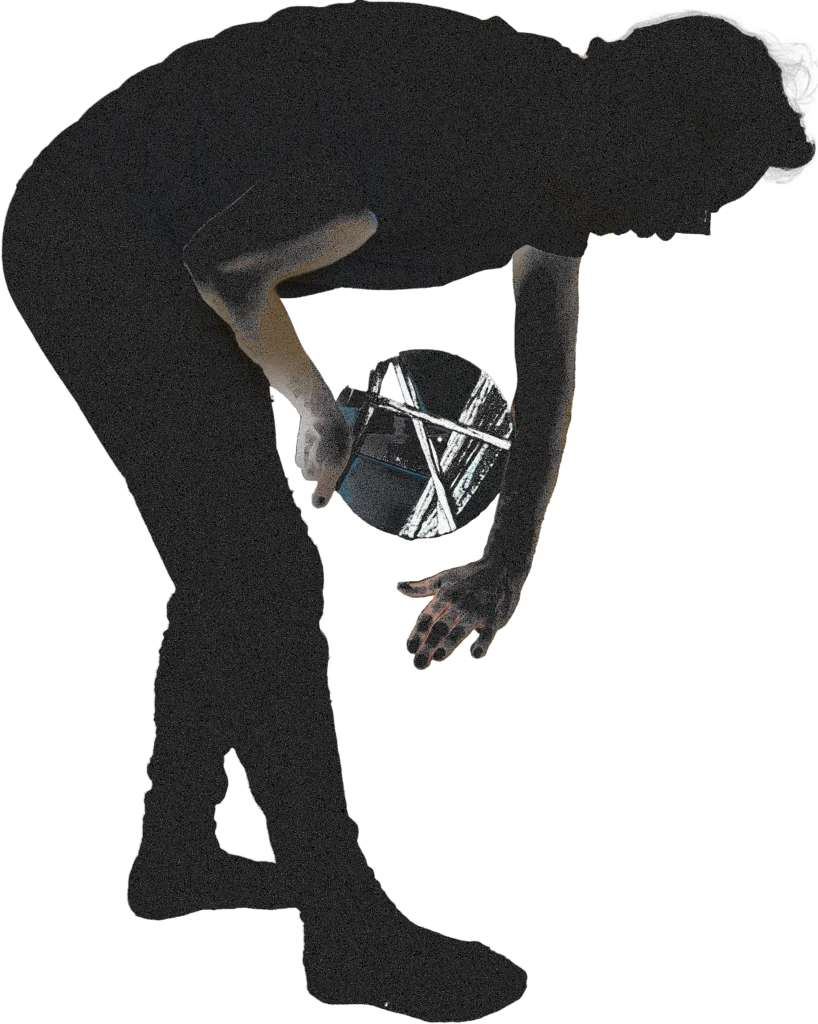
We worked the idea of translation as a methodological approach. We elaborated and developed on different modes of translation depending on the nature of the material that needs to be translated and on the phases of the process. From touch to movement, from movement to dance, from dance to description, from description to image building, from image building to collective storytelling. We worked with feedback loops to reassess translation as an ongoing operation. We recorded our long conversations and experiments to enable the documentation and sharing of the research in later stages.
1. A space to touch – Aaron Richmond brought to the studio several materials from the recycle depot CURCC in Concordia. Materials range from bleu foam in several sizes and consistencies, wooden ramps and sticks, a ventilator, a rubber suit, carton folders, bleu rain coat, monitors from m the 70’s, old cameras, exotic fruits wrapped in plastic nets or film, hair caps, ….They constitute our landscape to touch. “I remember the first verses of the book Parable of the Sower, by Octavia Butler, which I read throughout the first Covid-19 lockdown. The story tells about a dystopian world where survival becomes the only concern of all living creatures, humans, and non-humans. Despite the dystopian reality, a sense of hope is carried by the main character, the 18-year-old Lauren Olmina. She believes in community building and in the possibility of re-seeding a new world. A world she doesn’t know yet. To support her belief, she collects all the knowledges at her disposal: books, tools, guns, seeds, landscapes and behaviors. She writes verses in her diary as a way to communicate her thoughts to others. The first verse is:
“All that you touch
You change
All that you Change
Changes you.
The only lasting truth
Is Change
God Is Change.””
2. Duration – Staying with the Trouble
3. Somatic dances – based on somatic work with the input of Diego Gil we develop our capacity of reception and of engaging the body in the manifestation of what it feels when it touches the materials. A practice that feeds from touch to manifest relation. We work blindfolded to enhance the sense of touch. The book of Portuguese writer José Saramago titled Blindness inspired the idea that if we work with a diminish sense, we will rediscover our relationship to the world. With this in mind, we are practicing another sense of intra-dependency and hoping for a temporary entangled community to emerge.
4. Volume and directions
5. Intimacy and the erotic
6. No overview

7. Read and discuss texts to inform our dance practice – We read articles and texts about somatic, process philosophy, feminism, queer theory, black studies, the commons, to develop a practice that analyses and speculates simultaneously about ‘our’ relationship with the world (see references), to create a practice of thinking together by bringing different knowledges, stories, perceptions, and sensibilities to the same room. The goal is to work closely with these readings and observations in our descriptions and storytelling practice.
8. Syntax and storytelling – towards the hyper-object – We work with interpretation techniques to enable the relation between movement and words to create a meta-object made of the dancers, the dances, the objects, the linguistic and narrative aspects.
9. Practices of Attention
10. Documentation through scores – META SCORE – do everything as touch. Use the body, the camera, the microphones, language, the bodies as touching devises.
We worked with contact microphones, amplified voices and sound recording as witnessing devices under the guidance of Valentina Plata.
VK Preston worked on writing description. Writing as part of real time composition.
Heather Anderson worked on the translation of touch and discursive input of the others into dance.
We documented each phase through the creation of scores for improvisation. The materials are gathered in this website.
We worked with Lydia Graveline throughout the process on the construction of a website that would be the translation of our process in the studio.
11. The post-internet
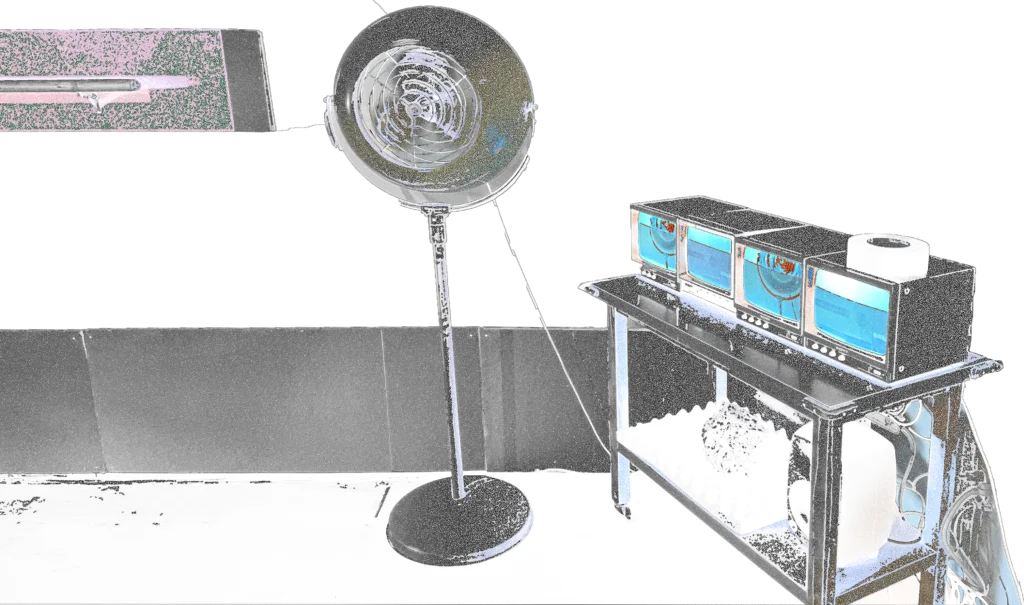
SIGNIFICANCE
The concepts of expanded choreography and transdisciplinary research are the two main overriding concepts that encapsulate this research. Expanded choreography is a term that has been used for the past years to open the meaning of choreography to other practices beyond dance making. The term allows for a critical exploration of its meaning since the first decade of the 21st century. This involves mobility of bodies, relationship with materials, construction of relational structures, social choreography, and systems of notation between other explorations.
I am seeing expanded choreography as a precursor and a friend of transdisciplinary research which is one of the key concepts in contemporary research in the humanities. Transdisciplinary practice evolves beyond disciplines to create new conceptual, theoretical, methodological, and translational approaches around a given problem to mend segregation and facilitate inclusion, equity, and repair.
SIGNIFICANCE
The concepts of expanded choreography and transdisciplinary research are the two main overriding concepts that encapsulate this research. Expanded choreography is a term that has been used for the past years to open the meaning of choreography to other practices beyond dance making. The term allows for a critical exploration of its meaning since the first decade of the 21st century. This involves mobility of bodies, relationship with materials, construction of relational structures, social choreography, and systems of notation between other explorations.
I am seeing expanded choreography as a precursor and a friend of transdisciplinary research which is one of the key concepts in contemporary research in the humanities. Transdisciplinary practice evolves beyond disciplines to create new conceptual, theoretical, methodological, and translational approaches around a given problem to mend segregation and facilitate inclusion, equity, and repair.

Meeting through… is performative installation environment that invites the audience to witness performance as a process-based work. The audience is implicated and part of the questions that the work raises and by giving instruction and actions of participation to those who are willing to contribute. By creating a space of exchange inside the performance space this project wants to facilitate access to questioning our response-ability to the world we are living in and sharing the troubles and anxieties that come with it. It wants to create a space of sociability that can host a sense of being with and induce will for staying with the trouble as a modality of repair. In this sense, this research-creation wants to commit in creating an engaged performative environment. And by doing this create a community of people concerned and willing to collaborate and develop further strategies of integration.
In a dystopian world I am trying to find strategies to bring to the fore the following notions: will for live, engagement, commitment, desire, community, resilience, resistance, and sustainability as values we need to nurture.
In parallel to this project and as a contribution to the process, I continue to practice ceramics to study material transformation through physical movement. I am interested in clay as one of the guiding materials for this research because of its ability of transformation, for it being a direct earth resource, and for the community building aspect. Clay has a symbolic value regarding human development, sedentarism and community that I want to address. Clay helps me to keep in touch.
I arrived to Tiohtià:ke/Montréal in October 2022 and acknowledge the land where my work takes place. Thank you for hosting me.
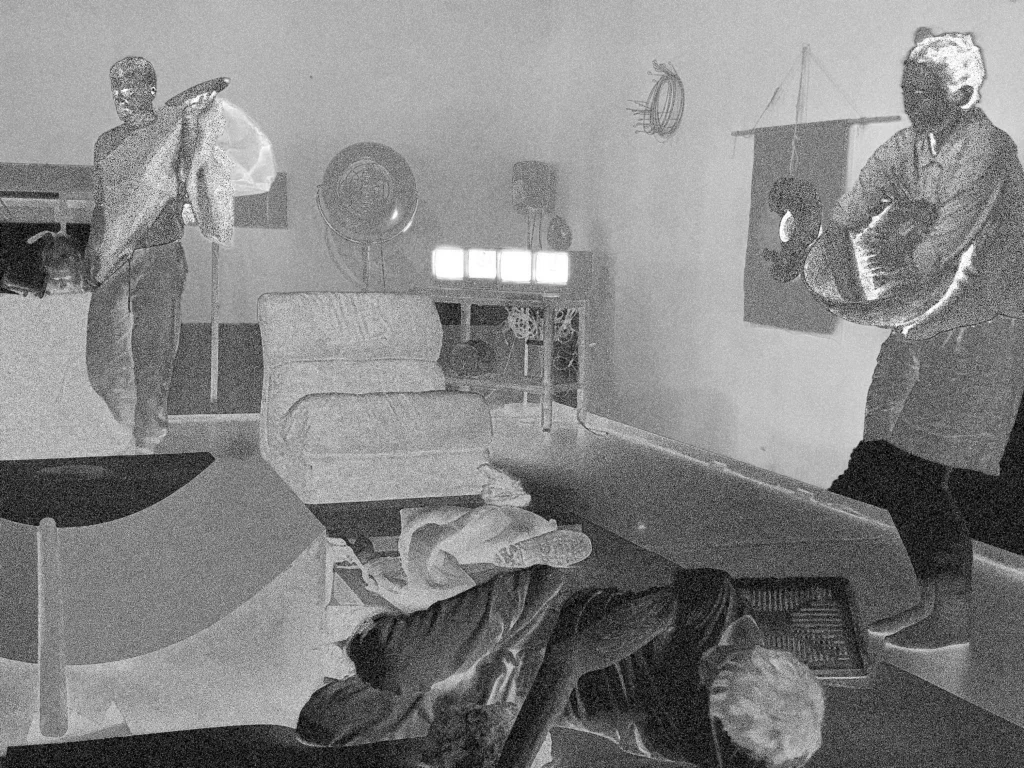
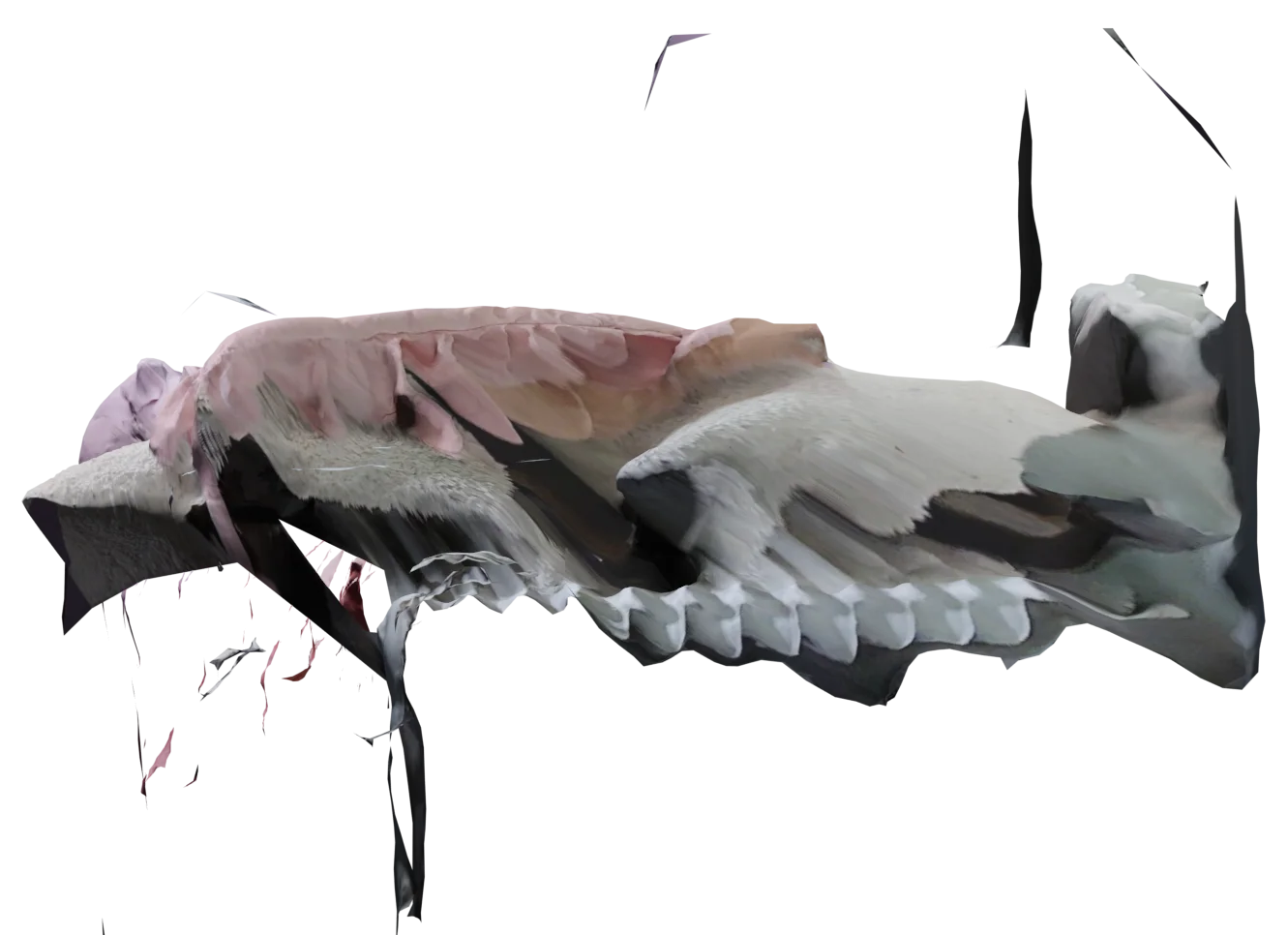
Research-creation project initiated by Lília Mestre with the support of a PCYIA Grant 2023-24

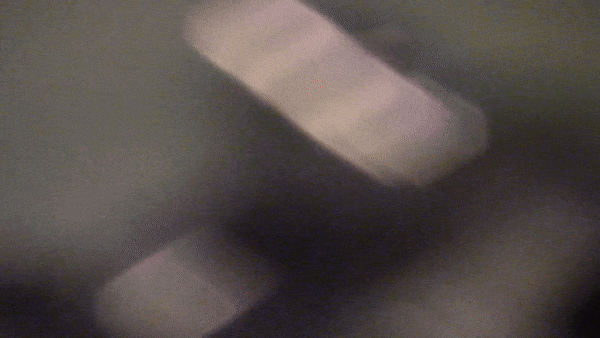
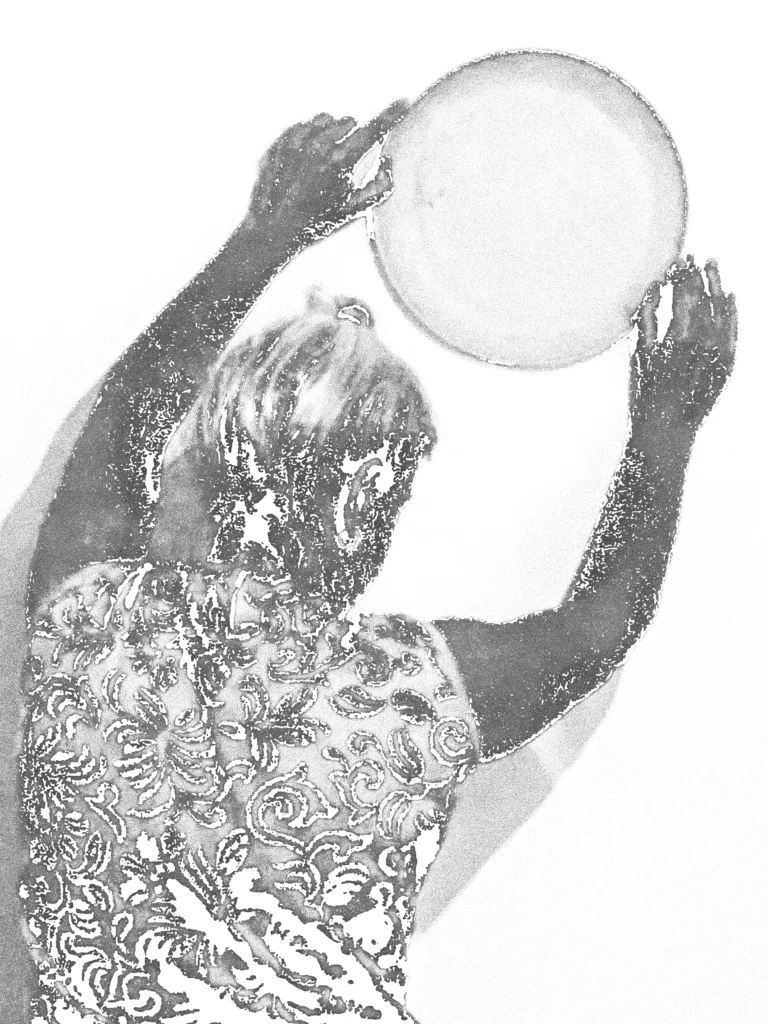
The no self-view is not a faceless, dehumanized abstraction, but a radical encounter with intimacy. What best explains ecological awareness is a sense of intimacy, not a sense of belonging to something bigger: a sense of being close, even too close, to other life forms, of having them under one’s skin. Hyperobjects for us into an intimacy with our own death (because they are toxic), with other (because everyone is affected by them), and with the future (because they are massively distributed in time). Attuning ourselves to the intimacy that hyperobjects demand is not easy. Yet intimacy and the no-self view come together in ecological awareness. The proximity of an alien presence that is also our innermost essence is very much its structure of feeling.
Morton, T. (2013). Hyperobjects: Philosophy and ecology after the end of the world (p. 139). University of Minnesota Press.
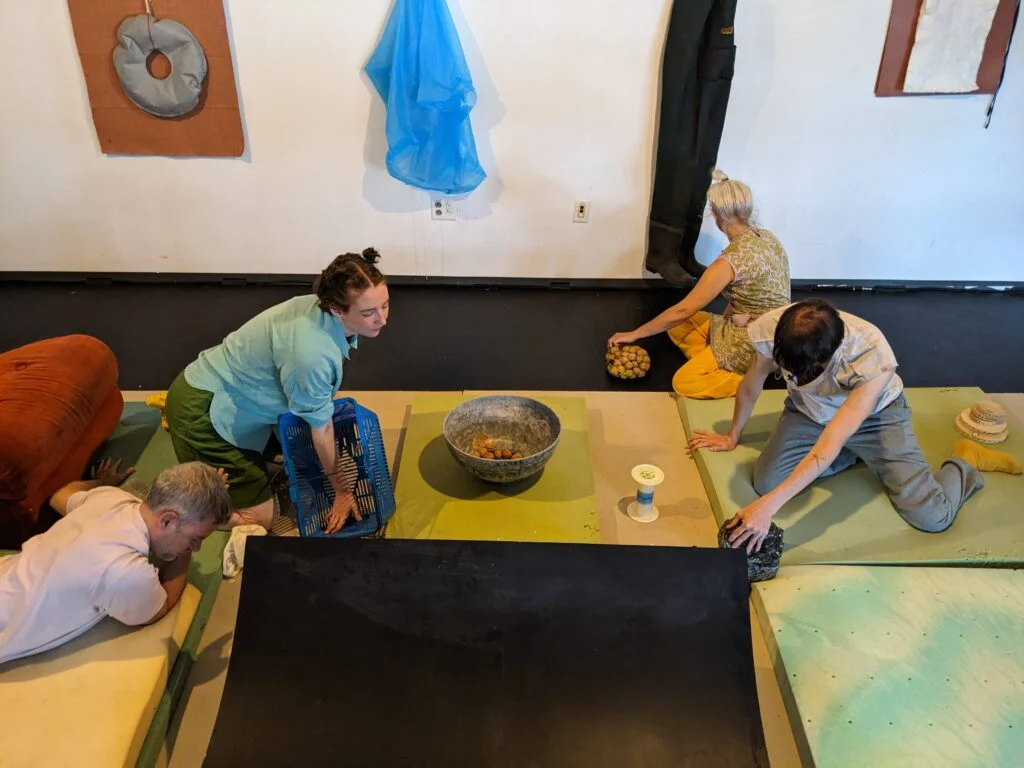
Aristotle’s Rhetoric is a profoundly original meditation on human affect- rhetoric is as much the art of listening as the art of speaking. But to what are we listening when we attune to the hyperobject? Is this uncertainty not precisely what we are hearing? Doesn’t the affect delivered to us in the rain, or through the weird cyclone or the oil slick, reveal something uncanny? If it has a name, it is weirdness.
Morton, T. (2013). Hyperobjects: Philosophy and ecology after the end of the world (p. 139). University of Minnesota Press.

Transcribed real-time witnessing, VK 27 oct
- The possibility something will
- Fall through my fingers
Excites me
Doesn’t really
Matter so I follow the
Cascade on skin
Sound like
Place
Like mobiles
Like
Elements
Like bells
In a dance so intimate
Touch is
Undone
VK*
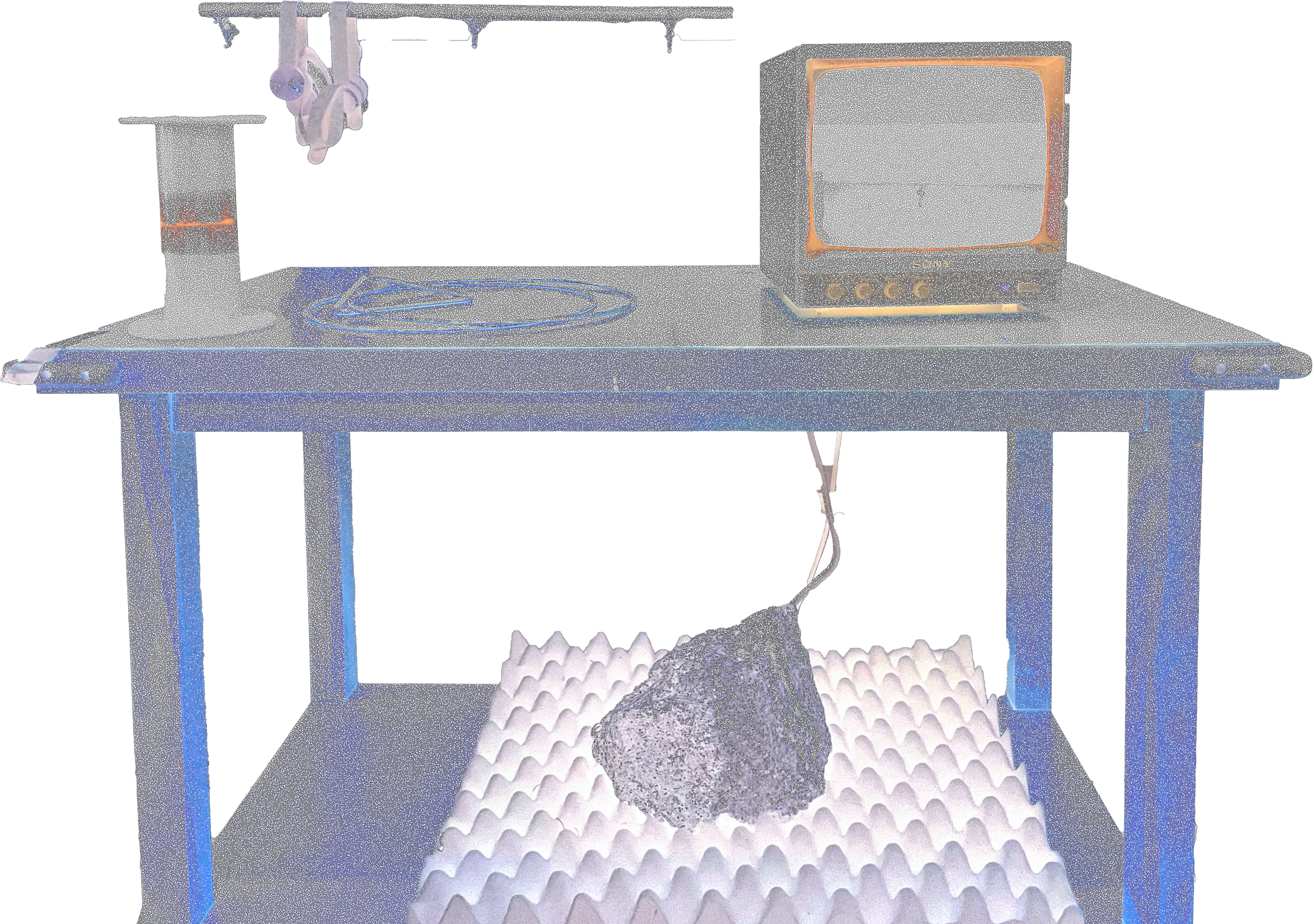
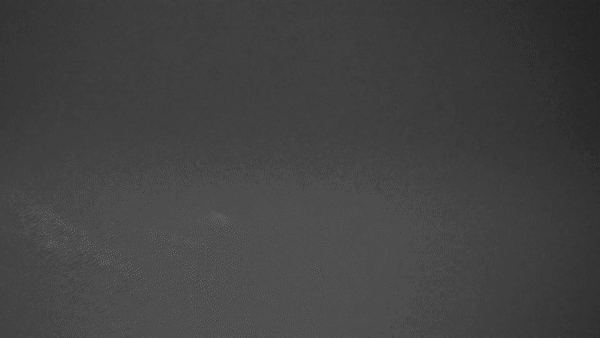
We may not yet know how we are connected to the world, but we do know that we are.
Landing Sites. Arawaka and Gins. 2002. University of Alabama press

Gins, M., Arakawa, S. (2002). Architectural body. University Alabama Press.
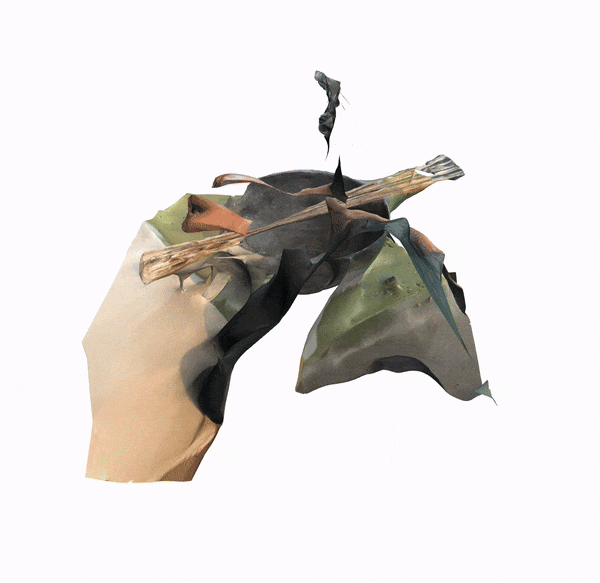

The taking of a particular expanse or event to be a landing site happens in a flash; over in a flash; these events that are decision like but far from being decisions yield to whatever can come next. A bit of substance, a segment of atmosphere, an audible anything, a whiff of something, whatever someone notices can be declared either a whole landing site or part of one, or both of these at once. Through landing-site configurations, organism-person-environment takes hold and holds forth.”
Gins, M., Arakawa, S. (2002). Architectural body. University Alabama Press.
Harney, S., & Moten, F. (2021). All incomplete. Minor Compositions & Autonomedia.

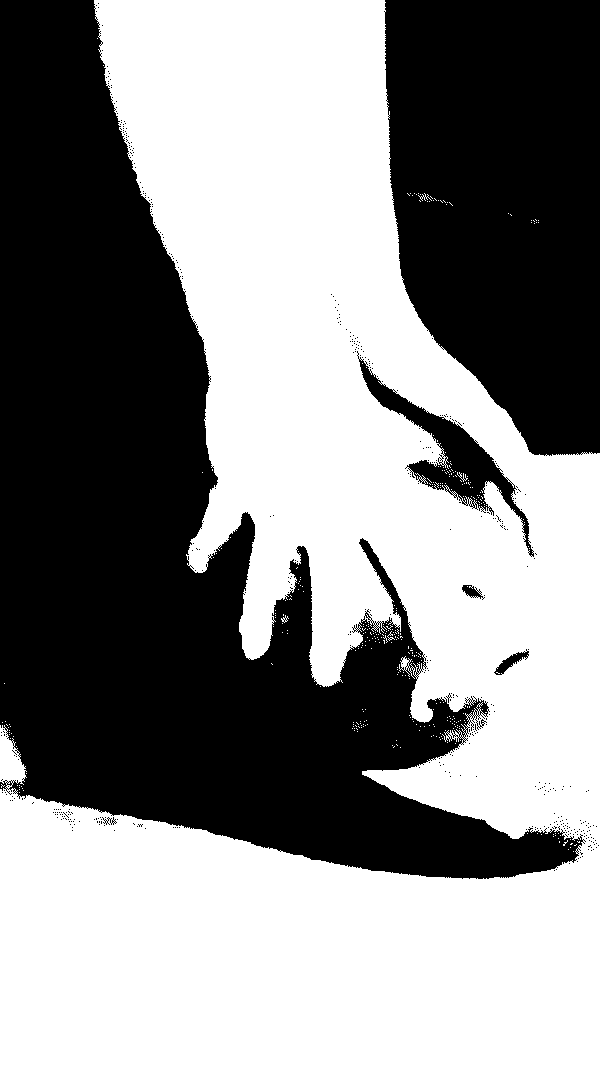
In determining her surroundings, a person proceeds by registering a ‘this is there’ and a ‘more of this here’ and a ‘more of that there’. In fielding her surroundings, she makes use of cues from the environment to assign volume and a host of particulars to world and to body, complying with what comes her way as best as she can. Her fielding of her surroundings never ceases, continuing even in sleep. Whatever comes up in the course of this fielding should be considered a landing site.
Gins, M., Arakawa, S. (2002). Architectural body. University Alabama Press.
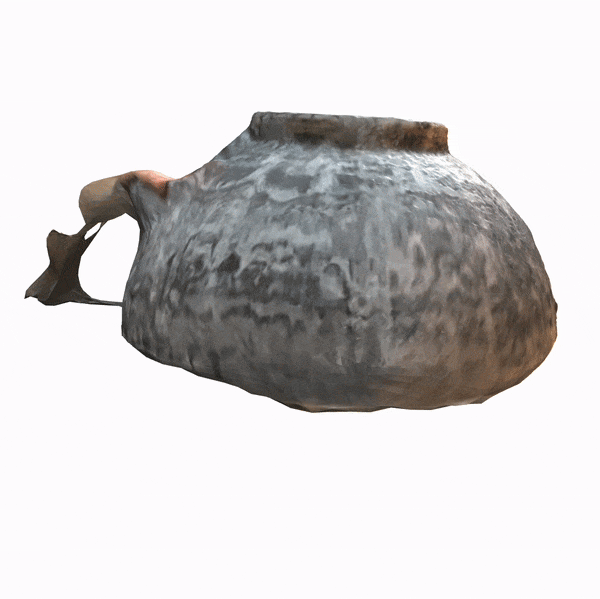
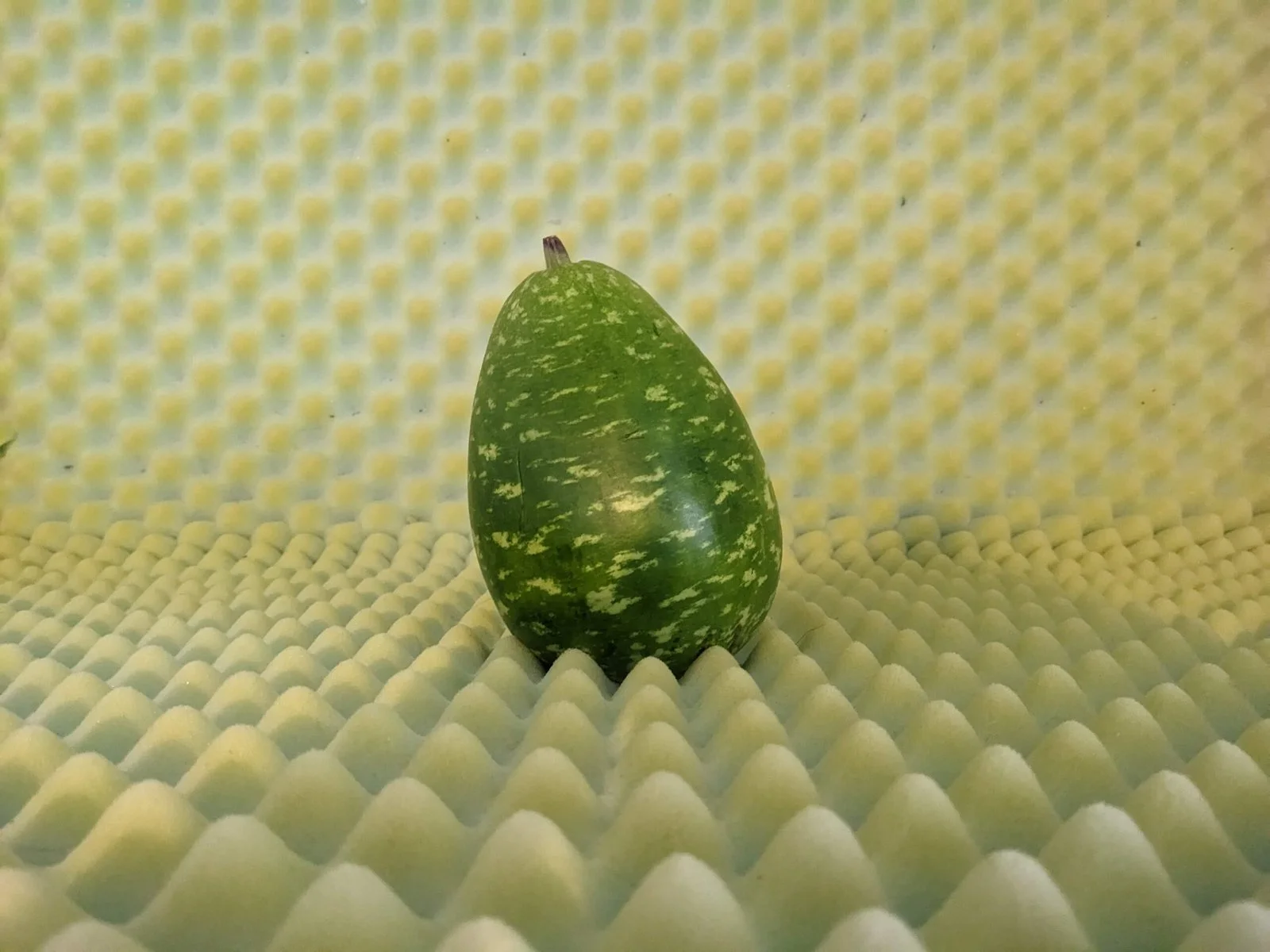
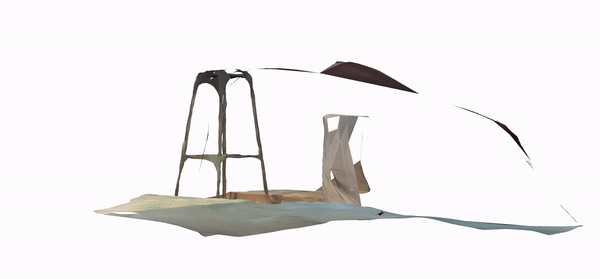
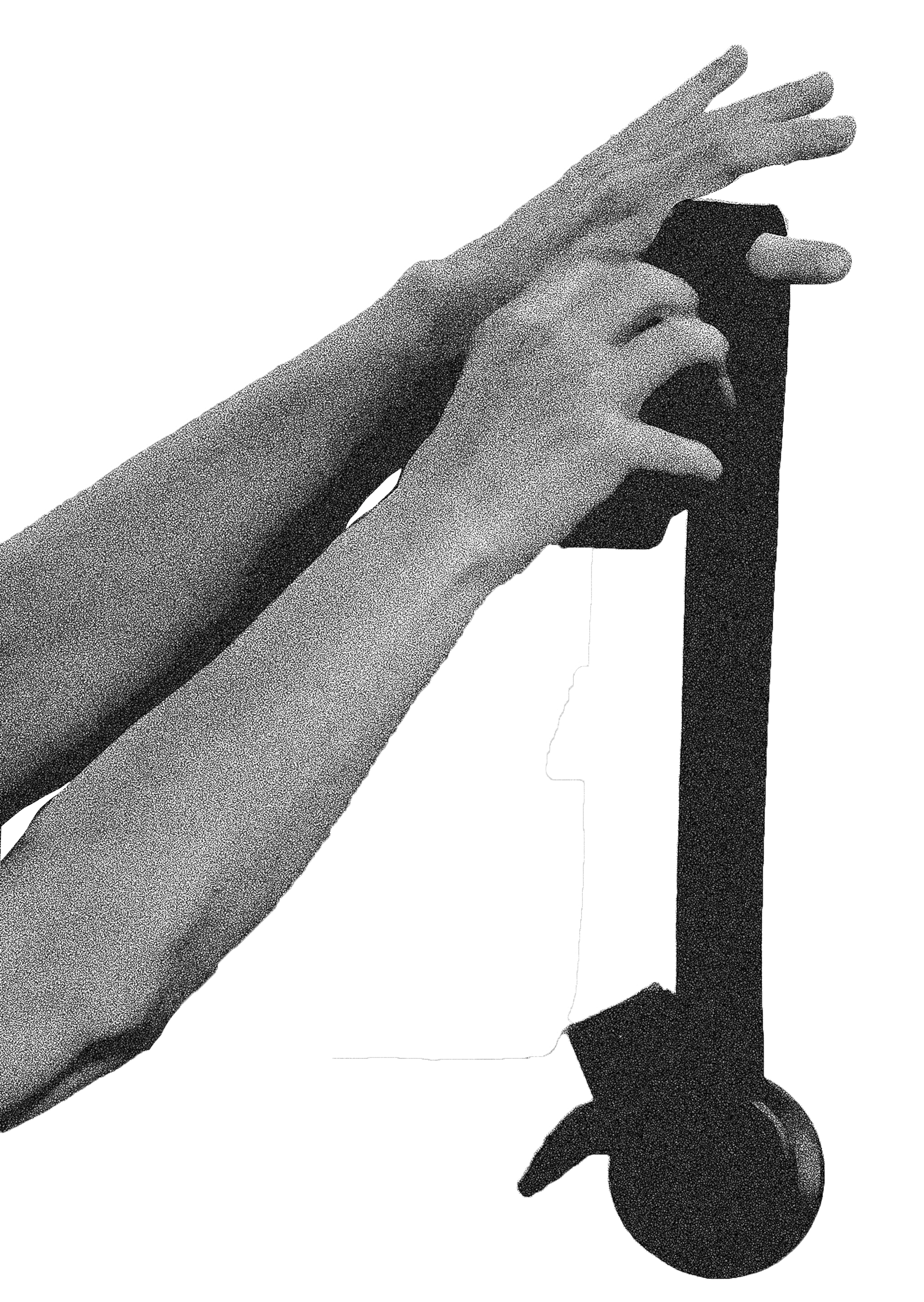
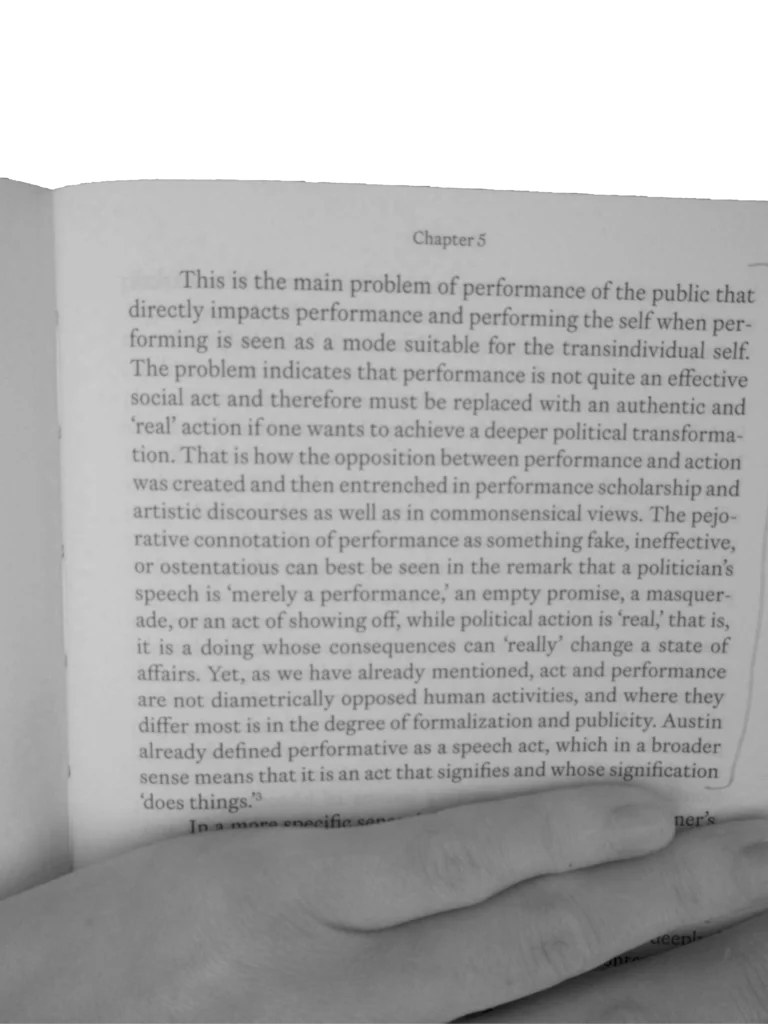

Conversation Excerpts
Heather: Yeah, it's interesting how the objects are these initiators of transformation. Like a bodily transformation is really happening, but then it's kind of this rippling that's happening around. And it's so funny, I wrote this down. Esteban, you said: "I am here, it is very long, and it ripples." And I was like, oh! There's a quality of poetry that's happening in it that is really interesting. But with that, too, there's also this, uhm, the questions we are asking each other are really doing something in the description, in that it's causing a call and response-
Esteban: I found that, too.
Heather: -that is happening across space. That's really, it's.. I don't know. I like the way that that is also initiating a type of rhythm, but also a type of relationship that's really interesting. There's something that I had questions about... like it felt very bacterial at a moment [VK laughs]. And then it made me think of this choice of like, who do we align ourselves with? Or, do I move with this one current, or do I stay as that other thing or am I a third separate [thing] not entangled in that mess? Like it made me wonder like when I'm doing this, do I have a choice? and maybe I have to be more conscious about the choices that I'm making, about who I'm making it with or what current I'm choosing to go with. VK it was really interesting watching you because you started out as just a very human body in the space and you felt very separate from what was happening but then as you got closer and you had to adjust your movement to not be touched or to not be in the way, it was like, it you becoming very still. It was really nice. Like having a stillness inside...
VK: I love, I didn't mean to interrupt, but I love the idea of the spectator is making a whole bunch of noise that's amplified, because you're so often in shows and you're like, oh man, 'don't make that noise. Don't drop, don't have the phone go off!' Like, vroom, vroom. It's like a few more like, kwaaaah!
Lília: That's a nice idea.
Valentina: Yeah, aliveness comes with noises.
Esteban: Yeah. Yeah.
Heather: It really was a practice of animating. There was something really incredible happening. There was a moment of quite a bit of rhythm-tension-friction happening and I looked and the book in the back over here just had a page waving. I was really awakening the space. It's really awakening my perspective to look at the space as intra-active, like really affecting. And so, I am left with this question of how are we affected? What is the choice in being affected? What does it mean to be affected? All of that. Yeah. Yeah, is there anything else? Oh, color was important, as well. Just having the differences made the most- when there was the most difference, it's when I felt you were in the most of it. It was the most coherent. I don't even want to say coherent, maybe. I don't even want to say coherent.
Heather: Yeah maybe vibrational [group laughs] or like it was, it was-
Esteban: Resonant?
Heather: No... I'm going to think about it. I don't.. I take back coherently. I don't want it.
Lília: Yes, I understand.
Heather: But yes, speaking, or something...
VK: I didn't mean to interrupt, but I felt that, too. Like there would just be moments where I can see too many things in this image because.. there's this cool moment where I was.. One of you guys was filming something and then all of a sudden you turned up in the image and I'm like, but you're not over there, you're over there! [Laughter] And I was just looking at the rectangle, I'm like, 'huh?' And then it was that mirror, so just everything had lined up so that you looked completely sharp in the image because the way the mirror was working you easily could be right behind. And so there are these moments where I was like okay, so people are actually moving [laughter] they're not where I think they are which, obviously, I mean I know it's a mirror, etc. But it's nice, and then sound does that as well and so on. Like they're really nice moments where when you start to pay attention and you start to pick up transpositions that are happening.
Heather: Yeah, exactly! It was like sitting in a forest, and you hear this, and then the thing scurries. But you can sense how it's all listening together.
Lília: That's fantastic.
Lília: I feel you. Looking.
Heather: Yeah, yeah.
Lília: So, that's very important. Because I think it works differently when there's people paying attention.
VK: Totally. Yeah, I never particularly like doing it on my own. Just to improvise on your own in a room is not the same thing.
Lília: No. Unfortunately, sometimes you need to do it [laughs]. But yeah. I felt the attention, I felt Lydia also in the room. As someone that doesn't know the process. Someone that is new. So, this is it, it does something. Yeah! It's great.
Heather: Okay, wait, I have two more things, because they just were important moments in the practice. Valentina, you did a moment where you were touching the object, and then you started touching your body the way that you were touching the object. [Heather taps her body] And it made me think, what does it mean to also bring in a self-touch into it as well? What's happening with that is interesting. And then at the very beginning when the two of you came together and for a brief moment, and I don't even want to say a couple or I don't want to say like a duo or a 'same’, but it was just a moment of like, a very understandable relation that I wanted to see more of.... Yeah, even in the greater landscape how two things can come and leave and come and leave.
Lília: We also had a little moment with Valentina.
Lília: Yeah.
VK: And my camera was on the mat, so I'm like you-
Lília: Nice. Yeah, no. I didn't know.
VK: Okay, yeah.
Lília: Like small things, no? That, uh, [clicks tongue].
Valentina: Yeah, I felt so close again. I felt that I could go there and there, quickly! And using the mirror, it's like a... like teleportation. I could feel it. [Valentina makes quick, successive, whooshing noises]. And yeah.
Lília: But I also felt the room.
Heather: Yes. Yes.
Aaron: Mmm. Yeah.
Lília: Like this space shuttle. [Group laughs]. And this discussion, I think was very nice. I like the idea of 'here'. I'm here. Where are you? Are you getting to the edge?- I mean, these notions of positionality in 'I'm here', but of course, the world's traveling. I mean, location. So, I think this is very nice.
Lília: It was more a situation in a way. I think we created the situation there, no? Saying 'I cannot hear you', 'can you say again?' But it came about because there was a loud sound. Like an interference.
[Group agrees in sounds]
Valentina: Well, what you're saying about interference, I felt that this [microphone] became like a capturing device. I started moving faster because you, in the other session, went fast. So, I was like, okay, I guess I can go fast. And then this became kind of like- it was interfering. Like, you know when there's [Valentina makes static noises] and you're trying to find the right [static noise] for it to be.
Lília: Tuning.
Valentina: Tuning, yeah! That's why I think I bumped it.
Aaron: Yeah. That's how it felt at the beginning. That's how it felt to me.
Valentina: Yeah, bumping into...
Heather: It was like an antenna.
Valentina: An antenna, yeah!
Heather: It really was.
Lília: I had antennas also.
Aaron: I did, too.
[Group laughs]
VK: [In robotic voice] Beaming. Receiving.
Lília: But it was like a soundtrack of antennas, this thing, I don't know...
Aaron: With the mic? Yeah, but the connection, it did make me curious about that moment with the rhythm of that. Just like, what are the openings for merging two kinds of perceptual parts of the machine or something? Yeah there's something interesting about how they attach to each other, but then maybe come apart. Or how that happens within this set of practices, you know? Do you know what I mean?
Lília: I think that's the practice, right? Because the moments where it connects, either by image or sound - I think it connects in different ways. It's also not just one kind of connection maybe. Sometimes it is the text, sometimes it's colors. I mean, many things.
Heather: There's lots of access. Like there's many, many entry points and it's interesting finding them all while still going through this wider arc.
Lília: This I love. You said echo... echo location? I love this echo location. Like the whales.. That's something great to keep being attentive too. It's a good location.
Heather: Yeah, it's really happening. But it's also... I think because the temporalities feel important to it, too. Having something really slow with this... it gives a depth. It gives a sense of the space being more complex and carrying more than just the same. I think it's also really in the rhythms, the scale, the color, all of that is creating a depth but it's also in the temporalities of it.
Lília: Layers, yes.
VK: It's like making a thing of timbre too, right? Like it's not just like sound or sign or but it's got all this... context.
Lília: I think it's not so easy to perform ... but... we can do it, I think! [Laughs].
VK: But it's also a sensitivity.
Lília: Yes it's all of this. And also like tuning with oneself. So, after a while we know what are the things that we are doing. The way we are touching, the way we are talking, the way... It will be surprising, but it will also be something we know. And then we can do anything. I mean, sometimes it will be better, sometimes it will be worse. It doesn't matter,... So, I think all this practice now is to find a way of relating. [Lília makes many gestures and sounds]. Our language, in a way.
Heather: It's developing very quickly, for me. Like it's really a... [Heather makes noises and sounds with her mouth and body]. Sorry for the sound-transcript, you can't see me!
Lília: No, that's it! Yes. I mean, there will be more problems. And we want them, actually. We want the problems. If not, we won't go anywhere.
Heather: But I think the reason why I like the trying works so well is because it's already- You're already all in a relationship.
Lília: Yes.
Heather: You can already find it. And so, then the effort to do it as well is really nice to see. The like, the wanting, the desire. The desire to do it.
Lília: To do it, yes.
Heather: Yeah, exactly. Yeah, because it's already happening whether you want it to or not.
Lília: Or not. Yeah. Now, I mean, I think we are doing this all the time. This is our experience of life. [Lília makes many different illustrative noises and group laughs and makes sounds of agreement]. Things are connecting constantly. Also, like back, back, back noise, front noise, focus-
Valentina: Inside.
Lília: Inside!
Lília: This is the key we found today… There’s definitely a key there now, no?
Heather: Because it's that demonstrative, right? Like it's making the space with the grammar.
VK: One thing I'm liking is that the texts are really strong. I like good text, right? And so, it's nice to have the presence of that, but it doesn't have to be the reproduction of that, or the fidelity of that, or the meaning of that. But it's actually the presence of the thinking that's in the writing that is shared and may or may not arrive.
Heather: The echo of it.
VK: I really like that relationship with text because it's like the other elements, right? It's like the cameras.
Lília: That's it. The text is material like the other materials. I mean...
VK: And we don't even have to hear it. We know it's there. And I like that because I feel like there's this conceptual thing that has them in different orders and I don't personally think that's true, but I think that the way that we're working, really helped me to hear something written like this that was uncomfortable.
Lília: These texts?
VK: Yeah! Yeah, like ooh. You know, because then there's stakes to touch and there's stakes to being a body with other bodies.
Heather: Yeah, the risk of it. The risk.
Lília: I mean, this is something we can continue to practice. Now we’ve read one story, right? One and a bit. Also, if you want to propose something to read, it's very welcome. I also liked it a lot, it was a bit… yeah, it's biting. It was not nice [laughs]. The other text we read was more soft- I mean, it had some tough stuff as well! But the writing was a little bit more... soft.
VK: But I remember at one point we looked at each other and it's like, [VK whispers] I know who this is [VK laughs]. Because that person…
Lília: Yes, exactly. I know that person!
Lília: I shot a 5-minute video last time. And I think it will be nice to look at it. And then from there, spring to the next thing. I would like to speak, maybe this is interesting for you, on how what I see most is on how to work on the body as also an architecture. So not just, I mean, just?! [Laughs] a receptacle of sensation, but actually as an architecture. So, like on how sensation affects architecture. To see if we can open more to other expressions than just the internal. And there's something about the connection of an internal-internal with an external-external, in a way. Because also the stories, when we are telling them, they weave. So they cannot just be internal. Somehow, something has to be also reaching out, so the two things are pulling in two different directions. And then in thinking about this I thought that it would be interesting to maybe learn stories by heart. To have some material again that can be from different kinds, I think. But that it's known. So that it's not… so that it can function as memory but can also function as a resource for continuing the conversation. Yeah? So maybe for next week that will be great. It is something that can be a little… It doesn’t have to be a very long thing.
VK: Would you like us to go and find something? Or do you want us to draw from the material we’ve already looked at?
Lília: I think you can choose what you like. I mean, knowing it will come into this universe here, right? So, what does it call for that maybe addresses this connection but is also from something that is personal to you, but it's reaching out to a certain exteriority.
Aaron: So, it's sort of bringing citation or quotation into the space?
VK: So, we're not the authors?
Lília: No. You can be the author. I mean, you can be the author, totally. Like, you can write, I learned by heart. That's a nice title, ‘I learned myself by heart.’
Aaron: There was a… do you remember the film we saw at the screening at the Biennale, there was a film where...
Lília: They are remembering?
Aaron: They're remembering together.
Lília: Yes.
Aaron: Is that what you have in mind?
Lília: Yes. Yes.
Aaron: So, a bunch of different people know the same…
Lília: I was not thinking the same, but I was thinking about going to something. Going to something that you... And it comes actually out of... I see sometimes difficulty in talking or in having material. So, I thought maybe this is a good way to have material. Because actually our body is, we have it all the time. We are rehearsing it constantly. I mean, and the talking as well, but maybe the task is a little bit more difficult to grab.
Diego: But then the stories wouldn't be informed by the touch.
Lília: They would. I mean, it's messy. I mean, I want it to be the...
Lília: Yes. Yes. Like another material that comes from another sense… Hmm. Does this make sense?
Heather: Yes.
Lília: Then this also comes with the question of language. Do we need to speak the same language? Can we speak other languages? Other languages that we have? Can we exchange languages? It opens up all things of memory and embodied knowledge. Like embodying, and being embodied. And also, I think it comes from the question of past, present, and future, to be able to touch these different temporalities. So, what is memory? And how to frame projections? I don't know yet. I think we are framing projections somehow, because we are imagining. But a real futurity, we are not there yet. But probably there is also a kind of a technology to get to it… to not be in the present anymore, but to be in the future. The space now looks a little bit futuristic, I would say. Mainly that [gestures]. That thing, yeah?
Diego: It looks like an old future.
Aaron: An old future?
[Group laughs]
Lília: Yeah, exactly! Like an old future.
[Group chats and sets up video to watch]
Líla: This is the camera.
Lília: Mm-hmm.
Heather: Attached to the little wheelie thing?
VK: Oh, fun.
[Group laughs watching]
Lília: It's really strange. I mean, if you don't know anything, I think it's like...
VK: I love how it's the simplest machine imaginable.
Lília: I can imagine it's creature-like. That's how this creature looks. And the fact that we don't have control over what it’s filming I think it's really special.
Aaron: This is when it's on wheels?
Lília: Yes, that was Heather.
Heather: And it was really an impossible machine for me to figure out. And this is, I think, I was still really focused on what the camera was seeing. So, I'm interested to see what happens, because at a certain point I ignored it entirely.
Lília: It's better.
Heather: Yeah, I felt it too.
VK: I like it down there on the floor like that.
[Group laughs]
Heather: It's nice to think of my body in that way, too, like by extension.
Aaron: Who's got a cat? I need a cat.
[Group talks over themselves]
Lília: And then the drawing is also the same thing, right?
VK: I would love to do more drawing.
Lília: But in the same way. The drawing is actually made from another intention. It's not…The intention is not to draw. But it draws itself. See? The intention, we don't know what it is. What are you doing here? [Lília laughs].
VK: Feeling the stick.
Lília: Vrooo. It's very cool. It's very good. This one we found already.
[Group laughs]
Diego: You can send it to the fans.
Lília: To the fans? Yes [laughs]. Like look, it’s got a certain animality.
Heather: It's definitely a very different entryway into place, as well.
VK: It also makes me think of some things like the Mars land rover cameras.
[Group laughs]
Heather: It's nice to think of my body in that way, too, like by extension.
Aaron: Who's got a cat? I need a cat.
[Group talks over themselves]
Lília: And then the drawing is also the same thing, right?
VK: I would love to do more drawing.
Lília: But in the same way. The drawing is actually made from another intention. It's not…The intention is not to draw. But it draws itself. See? The intention, we don't know what it is. What are you doing here? [Lília laughs].
VK: Feeling the stick.
Lília: Vrooo. It's very cool. It's very good. This one we found already.
[Group laughs]
Diego: You can send it to the fans.
Lília: To the fans? Yes [laughs]. Like look, it’s got a certain animality.
Heather: It's definitely a very different entryway into place, as well.
VK: It also makes me think of some things like the Mars land rover cameras.
Heather: Can we skip ahead a little bit?
Lília: To what?
Heather: To when I'm really moving with it. Because you're right, when I'm using it as a camera, it's much less interesting than when I'm engaging with it.
Lília: It’s nice. You know there are so many things there.
Diego: You can eat them.
Lília: You can eat them!
[Group laughs]
Lília: And you can put it there? Is this recording? Yeah. I think it really helps to have a center. There's something about this... We move around it. I think if it develops, then probably things will go further. You made another, a little island with the tissue, with the red thing, so there was an extension.
Aaron: Which one?
Heather: That red sheet.
Lília: But also, the white thing was a kind of an extension… And what is nice, it's also that thing, though. This and this is like, like what?! But there's something!
Diego: You can put them together.
Lília: Yes. There's a… I don't know... There's something.
Lília: So, what happened now in the beginning was very strong, I thought. Because there was one thing, not multiple things. I really think this is important. But it can be one thing at the time. It doesn't mean one needs to stay stuck to one thing, but actually to not engage with 3000 different things. Or not even two!
Diego: I find that I’m staying a lot in my hands, and I don't have a problem with that, to be very… (minimal) you know what I mean? Before, I felt like, oh, if I already put this on my hand… it's gonna be like... So, I tried to be...
Diego: You were already sleeping again?
Lília: I mean, but now this thing! It was so many things. This. The relationship with the thing changes, but also the body. In June, you did more of that. And now it's back. And I think this is very nice, because of the sustainability with just one thing. But you do many things, actually. And this is really cool. But then it's also great that everyone is different. You were also just with one thing, and indeed, just touching it.
So yeah, I could go back. Like, when I go back, I have a- there's a story, in a way. So, I don't need to follow. But if I go back, I go like, ah, yes, of course, this person was doing this and now it's doing that. So, I can connect the two points. There's something about that… because somehow you were touching everything, but you were very consequent in the way that you're touching everything.
Heather: What do you mean?
Lília: Well, it was mechanics. It was pure like this [gestures with object while speaking] there's like this and then also like that, okay, you can do like that and now. I don't know if it changes this and then… and also this and now I can do this thing. So, this is another possibility. One same relationship that moves through different things.
Heather: I felt like I had the same kind of movement vocabulary for each of them.
Lília: Or mechanics! Or technology. I think the same…
Heather: Yeah, like the pathway of it was the same for them.
Heather: Stay longer you mean?
Lília: Yes. Longer with each, yes. But it was very consistent. So, it was very interesting, because it was so radically different. The two of you were like [gestures]. But actually, it was gravitating. Very nice for the view, right? As a viewer, I can engage here and there. Sometimes it comes together. I mean, also this machine, this, or whatever that thing is. It's very beautiful actually. It was very beautiful when it came close to me, and I could see what it was recording. Really cool. It's very strange. It's like you literally can go inside the room through another portal.
Aaron: I wish this was just a screen. That the head was also a camera. That would be so satisfying. It would just hold a circle. That was both a screen and a camera. Because it was sort of helpful to look at it a little bit just to make sure that it's, you know. if it was just easy to do that it would be so fun to look at.
Lília: But it was just very nice and then a jacket disappeared or something.
Aaron: Your jacket disappeared?
Valentina: It was on my phone and keys in there.
[Pause to search for jacket]
Lília: So, this first part, it felt like searching for technology. How does it work? How does something work? How does the object work or the scene work? How can I touch it? How can I learn from it?
I think it can be very slow in the beginning. It's very sculptural, I wrote. There is something about posing, about tableaus, about image making in a way, as well. Like a bit of crazy image making. So that if things are held, I think they become strange and they become embodied at the same time. They have this double movement. Because it is happening in the becoming, it's too much to hold too long.
Lília: And what about the eyes?
Heather: Way more open.
Lília: Yes. Really nice to work with both eyes open and eyes close.. Because when I encounter it, for me as a viewer, it also changes my relationship with the work. Like when I see how you are operating, it's really like the mechanics of the body. Now it's entering through this channel. Now it's this other one. And I think this is very nice. I think we should just talk with eyes closed, actually, for now. Just closed. Then it's like a digestion somehow. Even if you acknowledge something with the eyes opened, you close your eyes before speaking and describing. I think we should also try to describe with our eyes open. But it totally changes the meaning. Maybe it's another stage of narrative, because it changes everything.
Diego: That's something that I now remember. When I wrote this comment about the performativity. I think it was related to that. Because it's weird when the moments are…, for instance, when the moments are not slow and when you are lying like this and speaking with eyes open it's almost too pedestrian, you know? I don't know if there's something like… the space loses intensity in a way because it opens too much. So that may be related to having a center where it's kind of okay. It could have too many derivations in a way...
Lília: I don't know what it is yet.
Heather: But it's just another temperature to try. A different way to work with the space and see what happens.
Lília: In a way, I have the feeling that the body or anything we do is actually an experiment to reach out and connect. This idea also came the other time where one [object] was the prosthesis and I thought to say that today. I think it really helped. I think you were, like the performing mechanics [gestures with object]. But also, the objects are our scientific instruments to understand what the ‘thing’ is. What the world is. So, every object is a machine in itself. And I think it's an object of inquiry. I think this is also important. So, it's never what we think it is.
Aaron: It's like a prosthesis with a moving function. And a moving sensitivity or something. It's not a prosthesis with one thing, but maybe one thing at a time. Like, it can change what it allows you to sense and to feel into and to move. And to restructure the space that you were taking up.
Lília: It's your entry point, actually. To the experience. And then we got the title: ‘It's not the same thing as before, that far I can tell’ [laughs]. I thought it was very nice. Something that happened then with P., because of the eyes open, was a sense of composition that I think is also important. Because there was a following up. Also with Esteban, with the walking in the beginning, and then walking on the thing, on this wooden ramp. And then hooked to Diego.
Diego: and [they] stole my object.
Diego: That's why you are so good at it. Because I was saying, oh, did you come for somebody? Is someone talking to you about the tissue or was that you who mentioned it? [To Heather] because you grabbed it from my hand and then I was…
Lília: I actually didn't see this. I couldn't follow.
Diego: I think that's also what I had in mind, in terms of transformation of this world of objects. In terms of if we are, for instance, like what's happening now, if we keep ourselves with a particular thing and then we get rid of it, and then we… I think we will be closer to a procedure in which we allow objects to be one at a time. Or I don't know. So, we also give them the opportunity to be the thing.
Val notes. 29 September
*We moved*
Micro macro, sounds with us
Objects · materials
What would you like to touch?
People doing one overlook and others improvising
Just with movement. Movement as description
What about citations?
The second body - Daisy
The resources shared
A statement about that
Books are my friends
Lilia loves people, books, and titles
The book in itself
A mapping of the process
We read and we massaged each other
Vehicle of touch
Tricky!! Exercise
Eleanor Webber person resource!
“It had a curve happening”
Where the curve started. First focus on the very beginning
Camera, holding, decisive
Recording therecording device
Multiplication immediately
Something to dig there
Everyone in their material taking a character (object/space)
Glass/horn/creature
Decisiveness
Fullness of the textiles
Walking with the spoon. Finding a kind movement
Negotiation of gravity, found outside established in some character
material produces you
In relation to it
Large scale/one to one
It kind of produce it
META META
There was something in that
Initially those were dispersed things. Are like trope what comes up in
materiality
Curious trope (asylum, inmate, separate, psychic)
What is the conversion?
How are these things related?
Speak it really starts to speak. Trope changes
Where are we?
Where have we landed in this space?
Speaking brings things together.
Fanning conversions
10 seconds rough wave… Similar energy. EMERGENCE
Disperse and then gathering of energy.
Ways of taking up the space
Ways of pronouncing
Consistent
IN!
Real power
Not speaking. Staying with it. Expand it
Generative. Generator. Largeness!!
Interesting in that
Internal worlds, asylum
Question.. How are these people in relationship with each other?
Let's hold it. INSANITY. This can only happen.
How to UNDO the trope
A space with that one
A rescue TROPE
I was interested in my own gaze.
Confused with, zooming in, zooming out.
Fragments what is going on
Whatever you do
Labyrinth
Anecdote
Layering of things
Zooming in. You had choices.
Juxtaposition so many worlds happening, you can FRAME
I am creating this connection.
Own choices own movement
Responsible to accompany all experience
Accompany the intensity. I can see someone else’s intensity. The nuance of intensity
Synchronization... But there was no soundtrack.
We are the sounds we are the soundtrack <3
Soundtrack is also the description.
Small percussive things
Val comment: reminds me of Jane Bennet wanting to put in the foreground the objects and humans in the background.
Collective narrator / soundtrack
Tools… what kind of content comes in
The question
I was really still in that story of a village, basement, child, sci-fi movie.
Language comes when there is already somewhere.
It makes me wonder of proximity.
What would it mean by sharing the object?
Foothold
Grammar
Personal question
Nature in the impersonal
How this impersonal correspond in a world.
Touch it for me.
Octopus!
Individual body
Resistance– isolation– to communicate – there are chances.
Audience eyes
Individual worlds. Collective world.
You are out of that score.
How do we INVITE?
Sensorial focused…
Are you part of that score… as an audience?
What comes out of this video…
Not have an overview
Composition globally
Blurry and then it becomes something.
I am exploring with the non-visual.
I am not working in a field of representation.
What is the awareness of the image?
I am seeing image I am not seeing sensation.
Recording. Point of entry… RECORDER
Technologies of representation. Magnification
If the recording was projected. Drawing
DRAWING TRACES
Choice of a blur, it gave a bridge.
I am very aware of things. Everything is a story.
Record being fidel, not loyal.
Blurry
Things that we are working it is not frame, correct.
Fluidity, attention, perception.
Formalization of movement
Very oppressive, you must formalize in order to exist.
“Taken seriously”
What is the point of entry?
Choice, FORM! Comes and goes.
Cinema is stuck!!!
Imaging, container, fleeting, it is a practice.
Today we found a shared story.
I felt less intimate.
Thinking about space! Not so intimate (meaning just with you the intimate word)
What is it to do it through?
Different ways, I don’t know what is better.
We will know our qualities.
We need to look.
Crucial to watch.
Sensing through somebody else
A third body
Humans = how to engage their sensorium
Light Shadows
People
Down to darkness breathing thing.
It changes an atmosphere.
Idea of sharing the perceptual change
CHILDHOOD <3 mood…. Instead of asylum
Letting go of the composition.
Desirable things
Enchantment
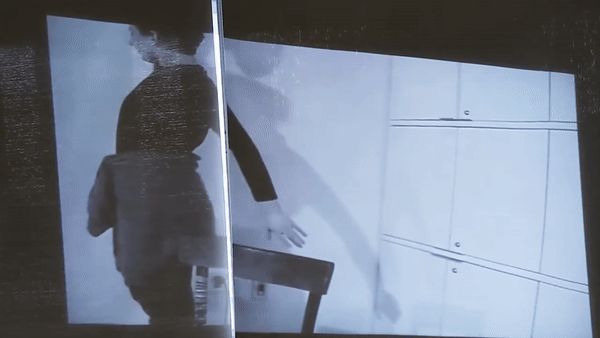
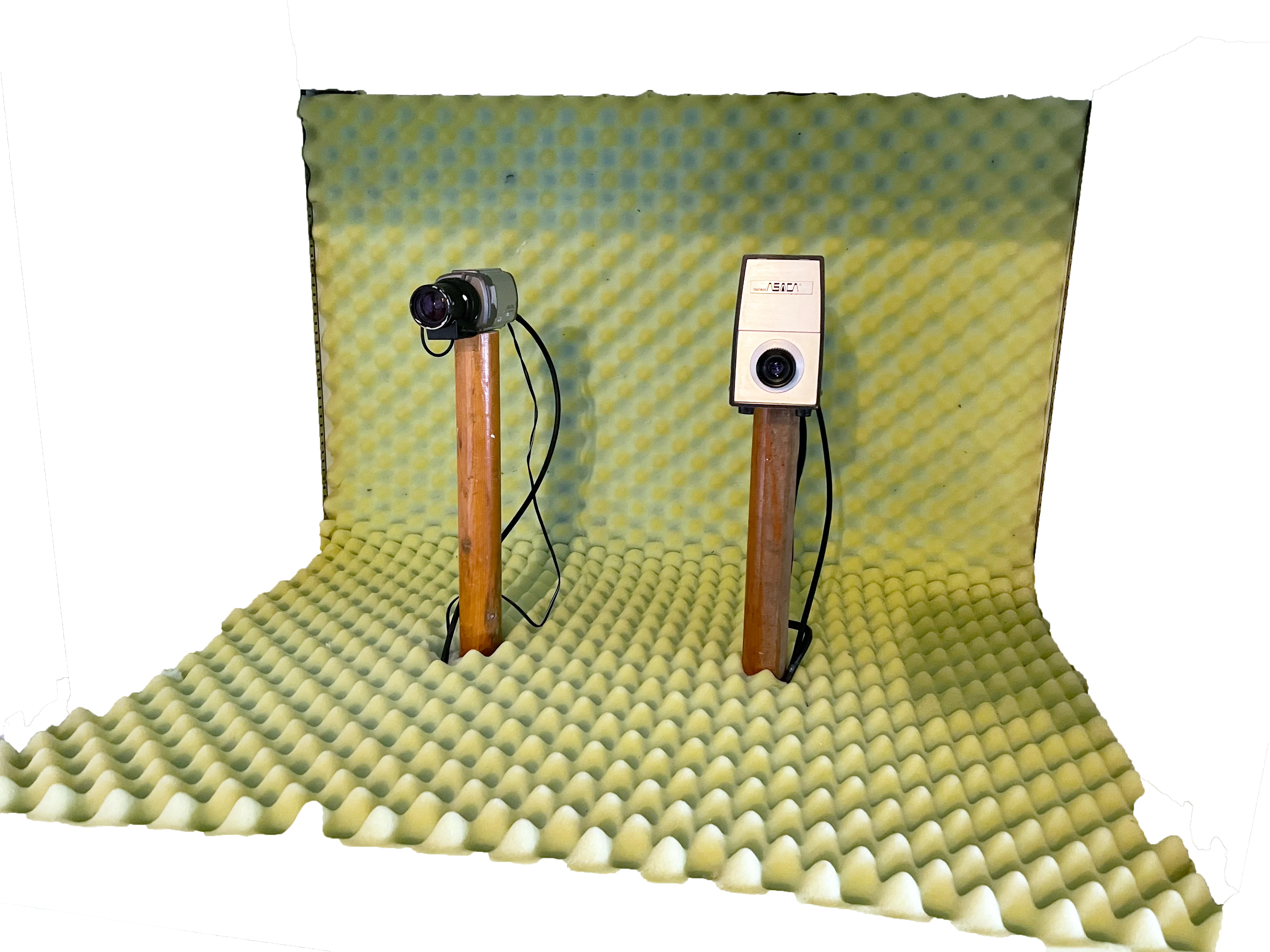
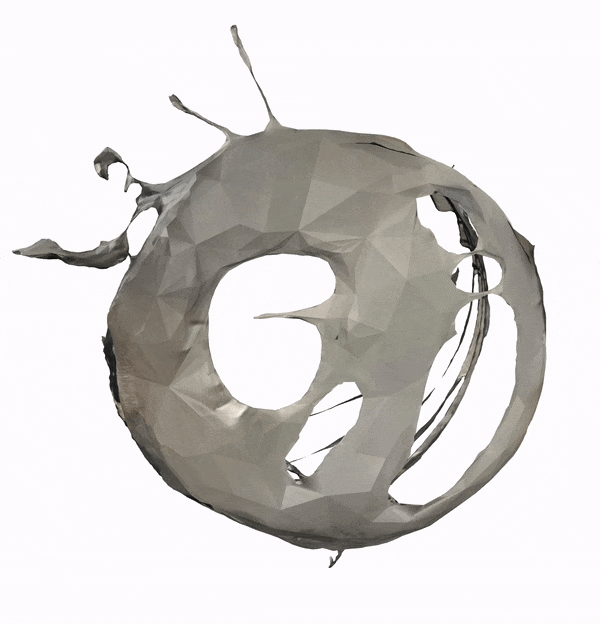


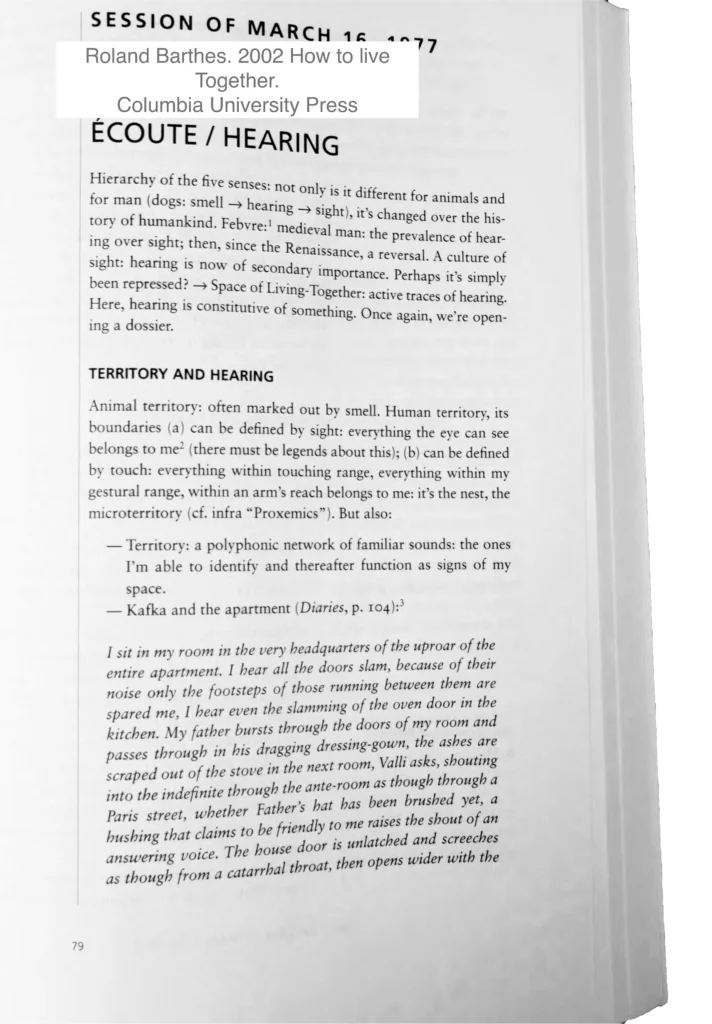
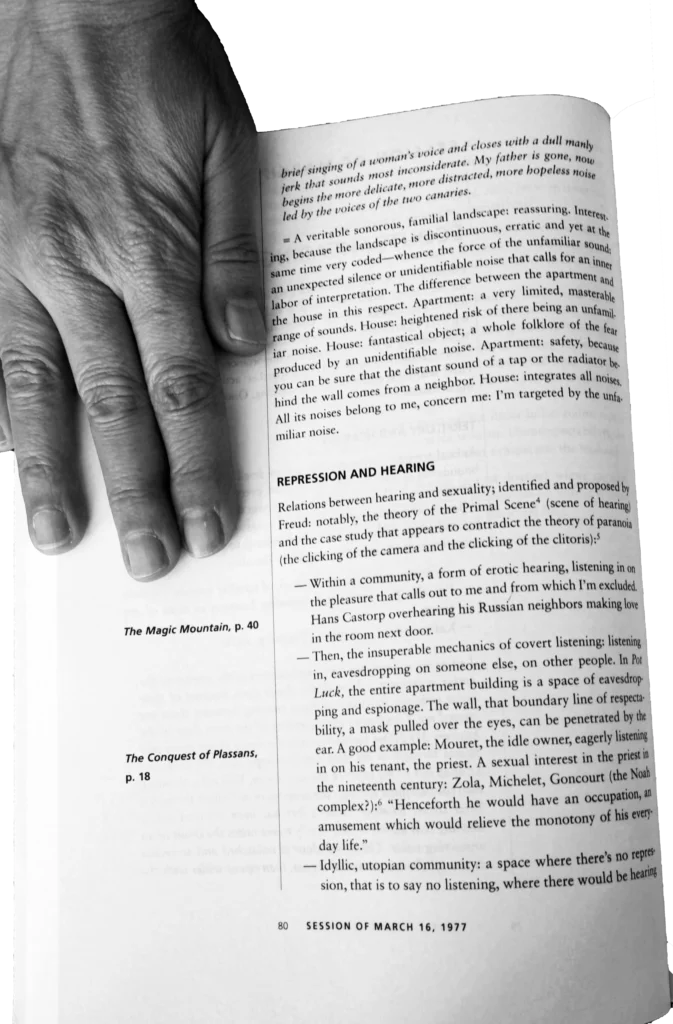
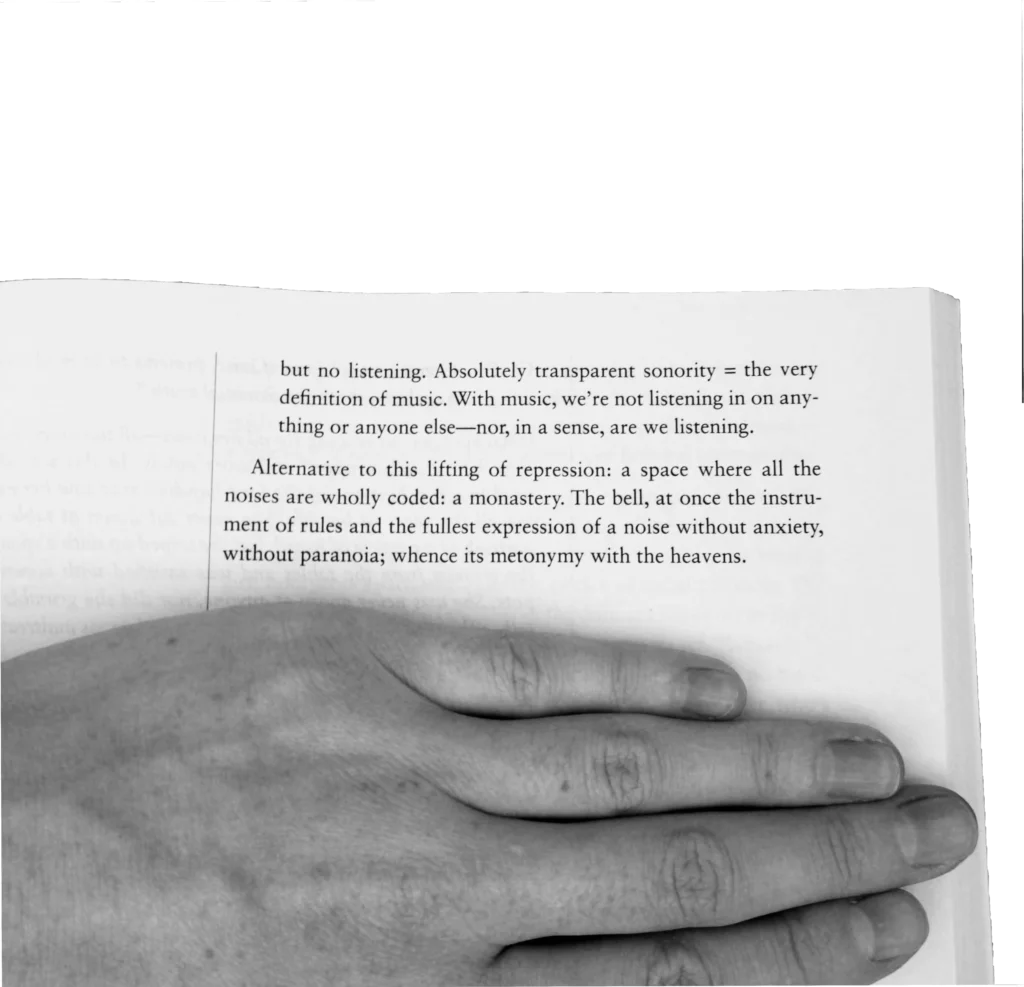
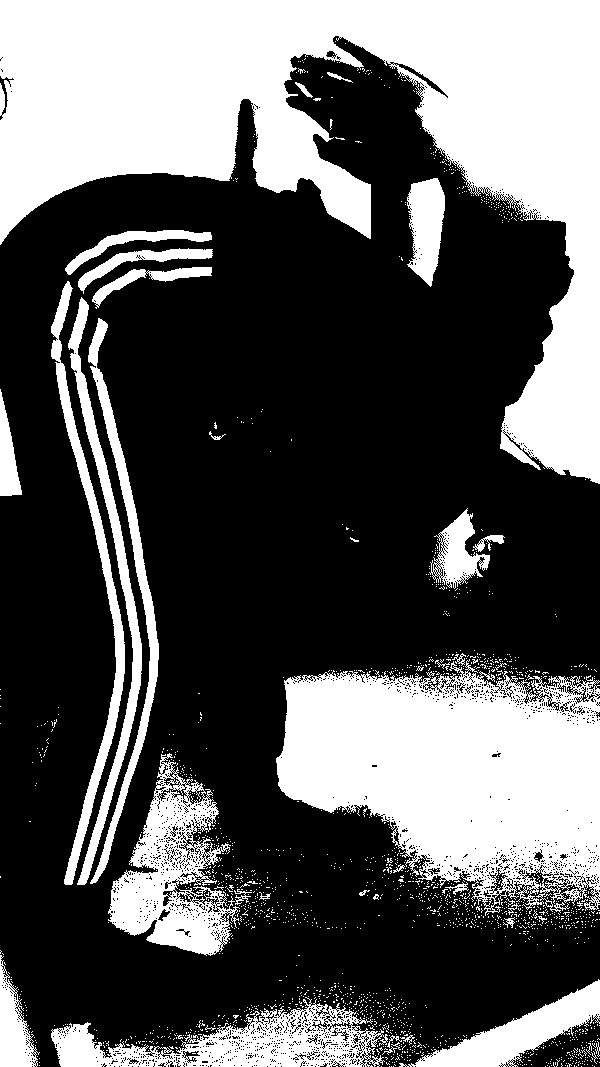


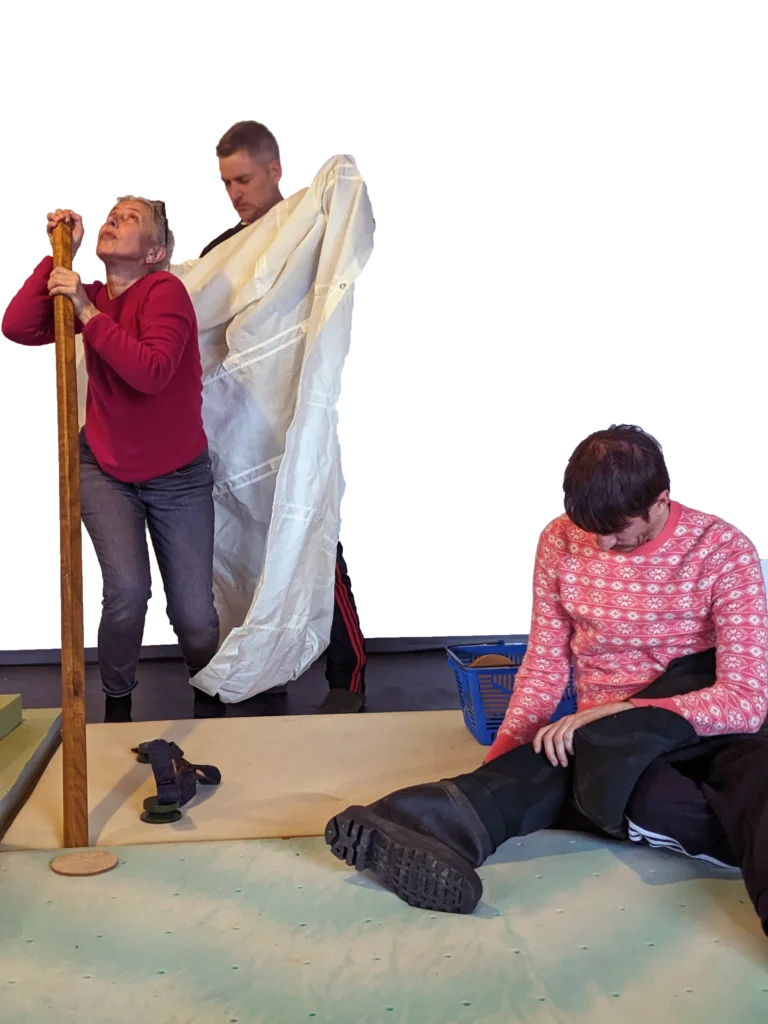

- A bowl simple
Holds and
Enfolds
Closes
Up the spill
In advance like a container
For future unfoldings
Withholding
Ribbons of
Flow
- Vertical sleeper
- Sail sheet
- Chain dragging
- In the water
- Cool white canvas
- Green like a sea ghost skimming
- Through skies
- Sprinklers singing
- The
- Prickle of foam
- Sea coloured
- Filled with mild voices
- Holes of sound
- Soft as a
- Siren pricking
- The sky like
- Thorns
*Transcribed real-time witnessing by VK
- Chalk like
Rainfall like
The sound of
Frozen forests
And ice storms
Wild breaking
Water with
The magic
Of materials
Sounding their
Clear tones
And dust

Is that not in the nature of touching? Is touching not by its very nature always already an involution, invitation, invisitation, wanted or unwanted, of the stranger within?
Barad K. (2012) On Touching—the Inhuman That Therefore I Am. Research Article. differences (2012) 23 (3): 206–223.
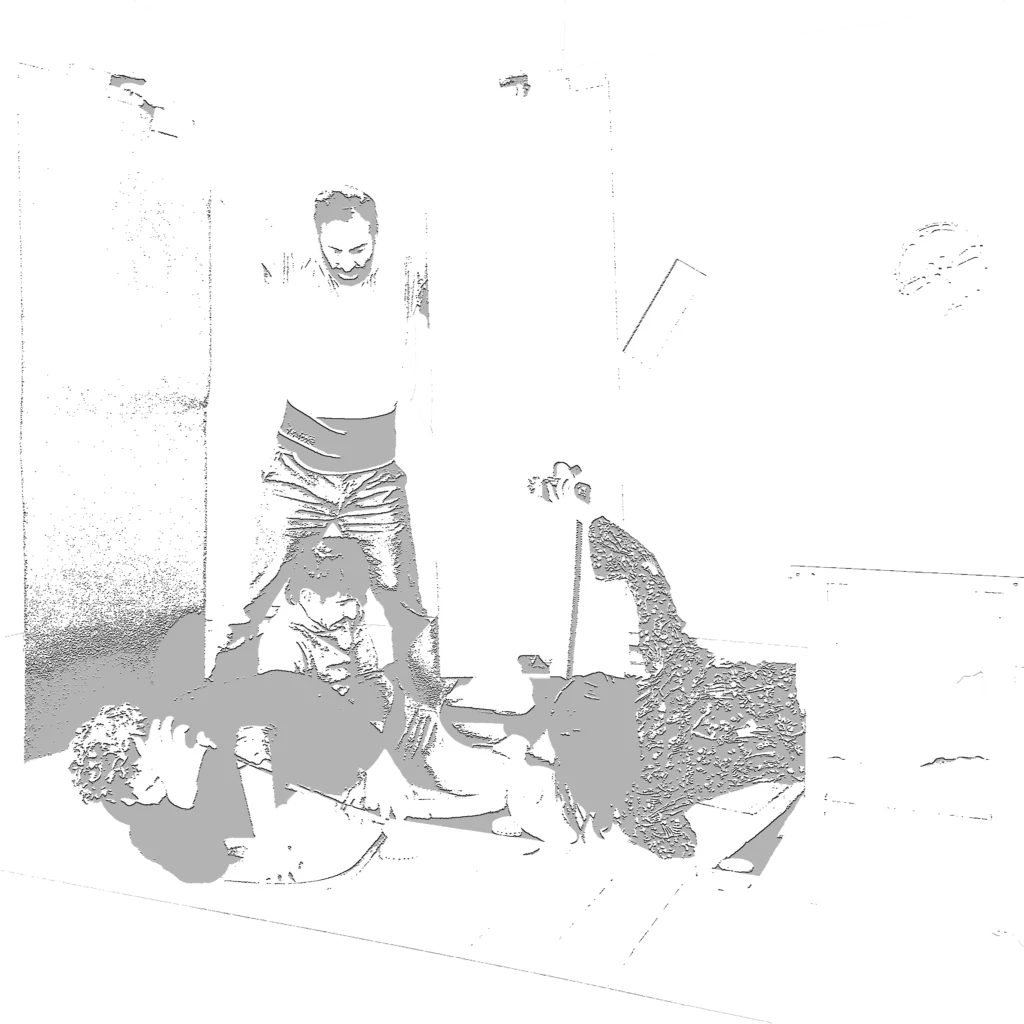

I dream of a world guided by a lens of stories rooted in the revelation of science and framed in an Indigenous worldview – stories in which matter and spirit are both given a voice.
Braiding Sweetgrass. People of Corn, People of Light (341 and 346). Robin Wall Kimmerer.
The story of our relationship to the earth is written more truthfully on the land than on the page. It lasts there. The land remembers what we said and what we did. Stories are among our most potent tools for restoring the land as well as our relationship to land. We need to unearth the old stories that live in a place and begin to create new ones, for we are story makers, not just storytellers. All stories are connected, new ones woven from the threats of the old.
Kimmerer, R. W. (2015) Braiding Sweetgrass. Milkweed Editions.
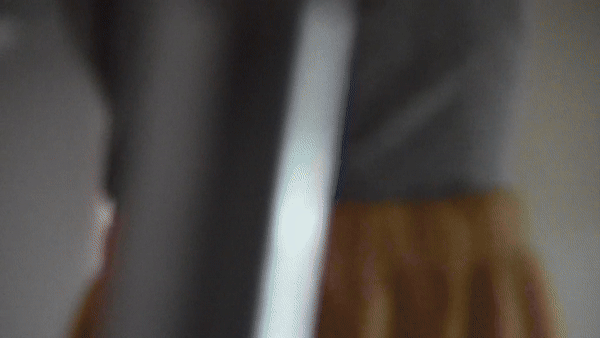
Barad K. (2012) On Touching—the Inhuman That Therefore I Am. Research Article. differences (2012) 23 (3): 206–223.


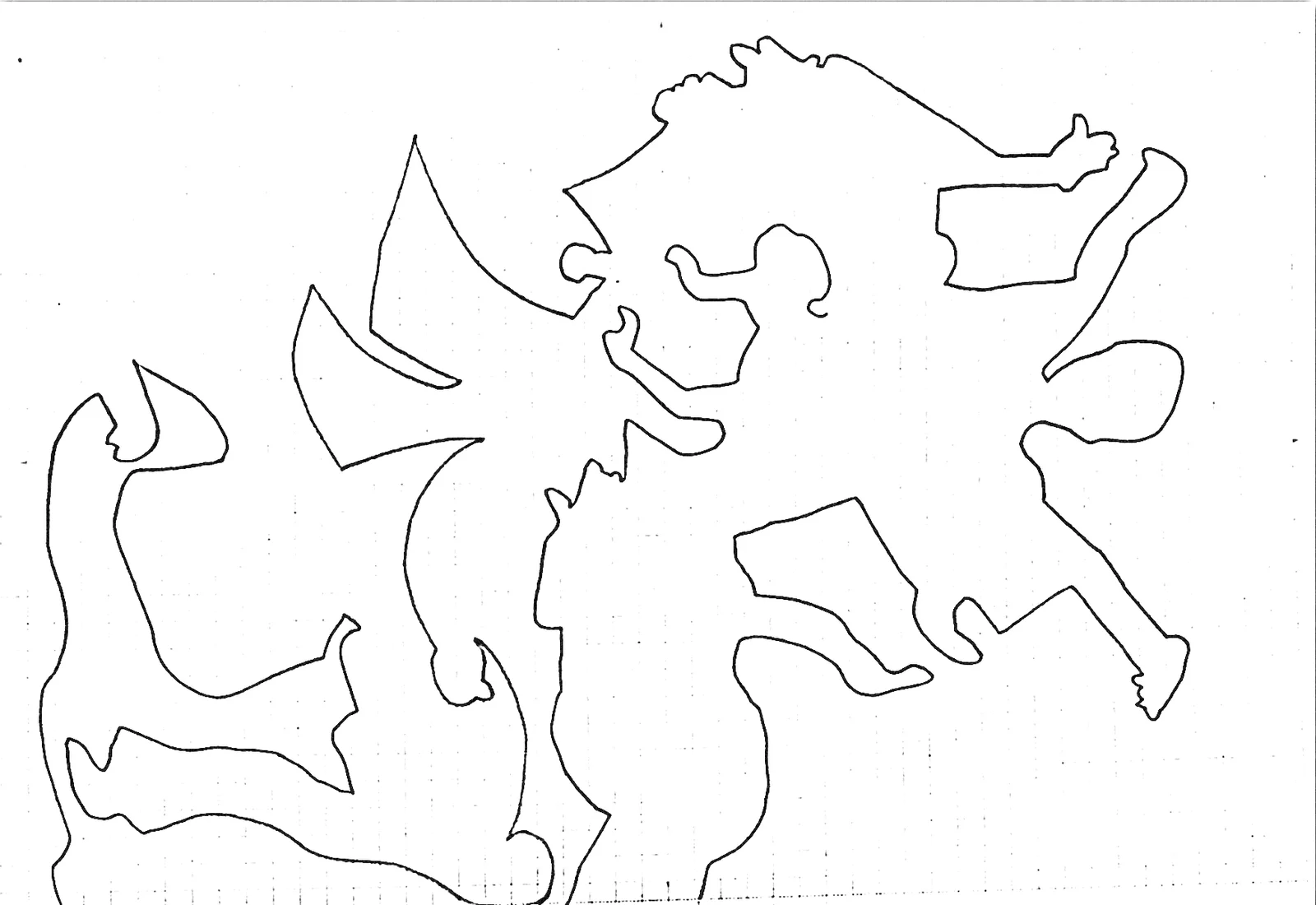
Participants
Heather Anderson
Esteban Donoso
Diego Gil
Aaron Richmond
Lydia Graveline
Valentina Plata
VK Preston
Lília Mestre
Thanks to Magali Babin, André Bocchetti, Jacob Wren, LePARC MILIEU.


References
Barad, K. (2007). Meeting the universe halfway: Quantum physics and the entanglement of matter and meaning. Duke University Press.
Barthes, R. (2014). How to live together: Novelistic simulations of some everyday spaces: Notes for a lecture course and seminar at the collège de France (1976-1977) (K. Briggs, Trans.). Columbia University Press.
Belcourt, B.-R. (2021). A history of my brief body. University of Queensland Press.
Bennet, J. (2010). Vibrant matter. Duke University Press.
Blind men and an elephant. Remembered parable – V.K.
Bragin, N. M. (2024). Kinethic California: Dancing funk & disco era kinships. University of Michigan Press.
Bresland, J., & Hodge, J. J. (2024). “Touch,” a video essay on the experience of always-on computing. Tri Quarterly. https://www.triquarterly.org/node/303191
Carson, A. (2024). Wrong norma. New Directions.
Cvejić, B., & Vujanović, A. (2022). Toward a trans individual self: A study in social dramaturgy. Oslo National Academy of the Arts.
Debaise, D. (2016). Nature as event: The lure of the possible. Duke Univesity Press.
Drulhe, L. (May 2024). Critical atlas of the internet: Spatial analysis as a tool for socio-political purposes. Louíse Drulhe. https://louisedrulhe.fr/internet-atlas/
Dumit, J. (n.d.). View of writing the implosion: Teaching the world one thing at a time: Cultural anthropology. https://journal.culanth.org/index.php/ca/article/view/ca29.2.09/301#:~:text=Haraway%20(1997%2C%2068)%20also,how%20many%20dimensions%20of%20a
Ernaux, A. (2022). The years (A. L. Strayer, Trans.). Fitzcarraldo Editions.
Gansterer, N., Cocker, E., & Greil, M. (Eds.). (2017). Choreo-graphic figures: Deviations from the line. De Gruyter.
Gins, M., Arakawa, S. (2002). Architectural body. University Alabama Press.
Guo, A. (2022). World of interiors. Divided Publishing.
Haraway, D. (2016). Staying with the trouble: Making kin in the chthulucene. Duke University Press.
Harney, S., & Moten, F. (2021). All incomplete. Minor Compositions & Autonomedia.
Hayakawa, S. I. (1948). Language in action. Harcourt, Brace and Co.
Hildyard, D. (2018). The second body. Fitzcarraldo Editions.
Krenak, A. (2020). Life is not useful. Polity Press.
Massumi, B. (2021). Couplets: Travels in speculative pragmatism. Duke University Press.
Maurette, P. (2018). The forgotten sense: Meditations on touch. University of Chicago Press.
Maynard, R., & Simpson, L. B. (2023). Rehearsals for living. Penguin Random House.
Morton, T. (2013). Hyperobjects: Philosophy and ecology after the end of the world. University of Minnesota Press.
Morton, T. (2013). Realist magic, objects, ontology, causality. Open Humanities Press.
Nelson, M. (2015). The argonauts. Graywolf Press.
O’Connor, K. (2023, July 5). Scores for improvising with ancestors. Stance on Dance. https://stanceondance.com/2023/06/05/kevin-oconnor/
Prentis, H. (Host). (2021, May 24). Seeds, grief, and memory with Rowen White (No. s2, e6) [Audio podcast episode]. In Finding our way. Finding Our Way. https://www.findingourwaypodcast.com/individual-episodes/s2e6
Saramago, J., & Pontiero, G. (1999). Blindness. Harcourt.
Simpson, L. B. (2016). Dancing on our turtle’s back: Stories of nishnaabeg re-creation, resurgence and a new emergence. Simon Fraser University Library.
Touré, A. J. (2021). Autowar. Brick Books.
UC Berkley Events. (2010, October 11) Diana Taylor: SAVE AS… Memory and the archive in the age of digital technologies [Video]. YouTube. https://youtu.be/xGurF1Rfj0U?sj=NVKvJ83vTYNV-H4Y
Unsocialized child in the village. Remembered Parable – Lília.
Zett, A. (2019). Artificial gut feeling. Divided Publishing.
Persons we think with in some way:
Jade Bennet
Gordon Matta Clark
Jack Halberstam
Stephen Jenkins
Lucrecia Martel
Aernout Mik
George Perec
Eleanor Webber